Read Time: 6 Minutes Subscribe & Share
Snowbound
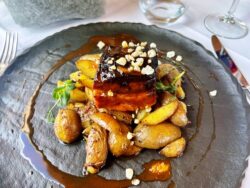 We were swept along on a ski trip (although we chose to walk very mild mountain trails instead) with our Italian/American family. Our first trip with them over a decade ago was to the “German” side of Alto Adige, but this time we chose the more “Italian” side. The abiding rumor is that the coffee on the Alto Adige side is terrible and on the Trentino side, it is as it should be. In truth, both areas have an intriguing and (most of the time) delicious amalgam of Italian and Austrian cuisine mixed in with a few nods to Hungary. But there is so much more….
We were swept along on a ski trip (although we chose to walk very mild mountain trails instead) with our Italian/American family. Our first trip with them over a decade ago was to the “German” side of Alto Adige, but this time we chose the more “Italian” side. The abiding rumor is that the coffee on the Alto Adige side is terrible and on the Trentino side, it is as it should be. In truth, both areas have an intriguing and (most of the time) delicious amalgam of Italian and Austrian cuisine mixed in with a few nods to Hungary. But there is so much more….
Not Heidi Land
The Dolomite Mountains appear almost extraterrestrial compared with the postcard images you have of the Swiss Alps. The range was named after the French geologist Déodat Gratet de Dolomieu, who was quite a character – a duelist who killed a man, quite a charmer to the ladies, a believer in the French Revolution until several of his relatives were guillotined, and a sufferer of inhuman incarceration at the hands of the Knights Of Malta. He was the first to recognize that the rock which formed the Dolomites was actually calcified coral and shells from the sea floor. Depending on the position of the sun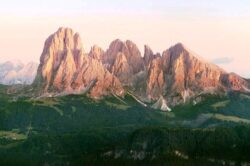 and the time of day, you can see a pinkish glow or shades of orange and red on the surface, vestiges of the mountains’ long-ago sub-marine life. And the shapes of the peaks are so different from both the Alps and the Rockies. According to the website that is dedicated to all aspects of this unique mountain range, Holomites.com
and the time of day, you can see a pinkish glow or shades of orange and red on the surface, vestiges of the mountains’ long-ago sub-marine life. And the shapes of the peaks are so different from both the Alps and the Rockies. According to the website that is dedicated to all aspects of this unique mountain range, Holomites.com
The Dolomites began “emerging” from the richly stratified seafloor during the Cretaceous – roughly 100 million years ago – due to a collision between the African and European continents. The folds and uplift caused by the convergent movements between the two plates created the Alps and the formation of the Dolomites. This uplift still continues today.
The beautiful photograph taken by Tobias Kaser for IDM Südtirol-Alto Adige reveals the almost evanescent beauty of the Dolomites. Click onto any photo to get an enlarged and clearer version.
Val Di Fiemme
This valley in the Trentino part of Trentino Alto Adige region is filled with forests, parks and towns that welcome tourists in warm weather and snow. In the area we visited -Predazzo,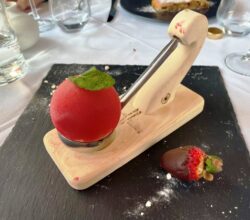 Cavalese, and Moena – all have websites to guide your vacation choices. We stayed in a modest two-star hotel –Albergo Pozzole – outside of Tesero, which provided comfortable rooms, breakfast and dinner. There is a bus system for guests in the area as well as a taxi service. We ate at diverse restaurants, ranging from a tiny family-run converted stable to an ambitious restaurant in Cavalese (the main course and dessert pictured are from La Stua). But you should save some room in your suitcase and visit some of the stores to purchase wines, spirits, cheeses, preserved meats — and even smoked trout. Ask your lodging host for a recommendation, as most of the vendors will have someone who can help you in English.
Cavalese, and Moena – all have websites to guide your vacation choices. We stayed in a modest two-star hotel –Albergo Pozzole – outside of Tesero, which provided comfortable rooms, breakfast and dinner. There is a bus system for guests in the area as well as a taxi service. We ate at diverse restaurants, ranging from a tiny family-run converted stable to an ambitious restaurant in Cavalese (the main course and dessert pictured are from La Stua). But you should save some room in your suitcase and visit some of the stores to purchase wines, spirits, cheeses, preserved meats — and even smoked trout. Ask your lodging host for a recommendation, as most of the vendors will have someone who can help you in English.
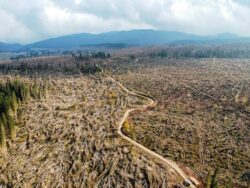 But this valley has withstood a tough history. Near some of the bloodiest battles of World War I in which Italy won this region from the crumbling Austro Hungarian Empire, the Piave area witnessed over 200,000 casualties in a few days. On October of 2018, this lush valley was struck by the Tempesta Vaia, a storm in which winds (followed by devastating rainfall) reached 125 mph and felled over 15 million trees — of about 42 million brought down in its path throughout the Veneto, Friuli and Trentino-Alto Adige. And in Tesoro in 1995, a dam broke and released within minutes a mud slide that destroyed everything and everyone in its path.
But this valley has withstood a tough history. Near some of the bloodiest battles of World War I in which Italy won this region from the crumbling Austro Hungarian Empire, the Piave area witnessed over 200,000 casualties in a few days. On October of 2018, this lush valley was struck by the Tempesta Vaia, a storm in which winds (followed by devastating rainfall) reached 125 mph and felled over 15 million trees — of about 42 million brought down in its path throughout the Veneto, Friuli and Trentino-Alto Adige. And in Tesoro in 1995, a dam broke and released within minutes a mud slide that destroyed everything and everyone in its path.
Of Violins And Beetles
Even though this region’s forest management is exemplary, Vaia birthed another ongoing devastation in the form of a bark beetle. While this beetle had been helpful in eating the bark of harvested and old trees for centuries, after Vaia, the remaining trees were considerably weakened and the number of beetles increased enormously, finding safe haven in the multitude of fallen trees. When you visit this area, you will see hundreds of these “ghost trees” wherever you gaze.
Communities in this beautiful area are fighting back with programs to replant this particular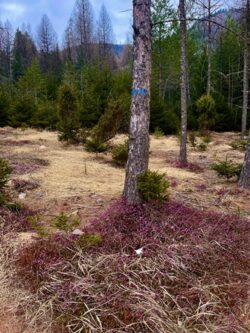 spruce and by diversifying the types of both pine and deciduous trees, by carefully harvesting fallen trees for lumber, and even by using pheromone traps. One of my favorite walks was through a forest near our hotel, in which we could pass by the frail gray wisps of dead and dying red spruce, next to some survivors and alongside new trees springing up close by, amid large stretches of forest heather.
spruce and by diversifying the types of both pine and deciduous trees, by carefully harvesting fallen trees for lumber, and even by using pheromone traps. One of my favorite walks was through a forest near our hotel, in which we could pass by the frail gray wisps of dead and dying red spruce, next to some survivors and alongside new trees springing up close by, amid large stretches of forest heather.
These forests of red spruce have provided wood for European crafts for centuries, from masts for the ships of the Venetian Republic to the violins made famous by Stradivarius. This particular Nordic Spruce is revered by violin makers (and other stringed instruments such as guitars and even pianos) for its unparalleled resonance. The clarity and pitch that the wood from the Val di Fiemme creates owes its success to the unusual combination of stiffness, flexibility and a surprising capacity of its lymph channels to carry sound almost like the most sophisticated hi-fi system. The “veins” of these trees are what carry the sound, and suitable trees are harvested only when their sap levels are at their lowest. The wood thus requires less than six months of “seasoning” in temperature-controlled rooms before being made into a classic violin. Lesser trees used in this famous craft (a top violin maker produces only a handful of violins annually) may take years to be properly seasoned. You can tour this area of the Paneveggio Forest and find other wonderful ways to experience the outdoors and pristine air by visiting this website. We definitely plan to return here this summer with friends.
An Unforgettable Dinner
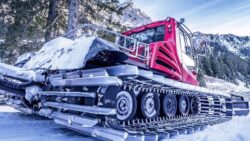 Our family crowned our stay, which mixed gentle walks and stunning views from our balcony breathing that marvelous Alpine air, with an unforgettable dinner at Chalet Caserina near the top of Monte Agnello. A snowstorm had hit, and our intrepid son-in-law drove us to the base of a mountain range of slopes at Pampeago. The return trip was even more fraught with hazards than the trip up, which had been plenty scary. From there, in blinding snow we climbed aboard (very gingerly) a HUGE snowcat and roared up to the restaurant. During a hair-raising ride up at incredible speed, I felt as if I were in one of the Star Wars sequels on a wintery planet in a galaxy far, far away.
Our family crowned our stay, which mixed gentle walks and stunning views from our balcony breathing that marvelous Alpine air, with an unforgettable dinner at Chalet Caserina near the top of Monte Agnello. A snowstorm had hit, and our intrepid son-in-law drove us to the base of a mountain range of slopes at Pampeago. The return trip was even more fraught with hazards than the trip up, which had been plenty scary. From there, in blinding snow we climbed aboard (very gingerly) a HUGE snowcat and roared up to the restaurant. During a hair-raising ride up at incredible speed, I felt as if I were in one of the Star Wars sequels on a wintery planet in a galaxy far, far away.
 We stepped out in the black night with snow swirling around us and entered into a cozy chalet restaurant, greeted by the boisterous and professional crew of Caserina with glasses of vin Brule. Candle lit tables were imaginatively set, and we ate a wonderful meal, which included a first course of mixed cured meats and cheeses, with miniature roesti and onion conserve, followed by tagliolini with local mushrooms, and then a drop-dead speck risotto, and, as if that were not enough, a venison braised in wine and an earthy polenta. I couldn’t believe that the dessert was a tiramisu done a la minute, served with coffee poured from large Bialetti Moka pots. Wine was optional for some, but not for us! Afterwards, we were bundled into awaiting snowcats for yet another blood-curdling ride down the mountain. More exciting and tension-producing than any amusement park ride – I would not have missed this dining experience for anything!
We stepped out in the black night with snow swirling around us and entered into a cozy chalet restaurant, greeted by the boisterous and professional crew of Caserina with glasses of vin Brule. Candle lit tables were imaginatively set, and we ate a wonderful meal, which included a first course of mixed cured meats and cheeses, with miniature roesti and onion conserve, followed by tagliolini with local mushrooms, and then a drop-dead speck risotto, and, as if that were not enough, a venison braised in wine and an earthy polenta. I couldn’t believe that the dessert was a tiramisu done a la minute, served with coffee poured from large Bialetti Moka pots. Wine was optional for some, but not for us! Afterwards, we were bundled into awaiting snowcats for yet another blood-curdling ride down the mountain. More exciting and tension-producing than any amusement park ride – I would not have missed this dining experience for anything!

Kitchen Detail shares under the radar recipes, explores the art of cooking, the stories behind food, and the tools that bring it all together, while uncovering the social, political, and environmental truths that shape our culinary world.




You capture your adventures in the Dolomites so well. The read is enchanting and funny and makes me want to have the same experiences in the same places. Good wishes for more exciting travels in Italy. Ciao!
Hello Joan,
Thank you for writing to me about this post, your comments mean a lot to me! Will write more about our adventures, although I am sure none of them will be as exciting as those two wild rides in the blizzard and that dinner!
Nancy
This was my first acquaintance with a snowcat! My husband Wolfgang and I did experience being driven, by a Swiss native, fast up a narrow one-lane road to a mountain restaurant in the Berner Oberland, There was no electricity and we enjoyed first a charcuterie plate,
then a salad, then sumputous cheese fondue by candlelight. Then back down the mountain!
Michele,
Great to hear from you! Your experience must have been truly out of the ordinary. We did have electricity, but I must say that after our wonderful dinner the ride down the mountain and then the drive back with my truly intrepid son-in-law was something else!.
Nancy
Nancy, this is such gorgeous writing!! I felt like I was with you — screamed as we road on those twisty Italian mountain roads in the snow. Whew! Glad you are back safe and sound to share with us these fab stories. Love them. Love ❤️ you more.
Mary M
Mary!
So good to hear from you! Did you get my email? Would love to hear news from you and your family.
Nancy
What on earth is the desert? Looks like sherbet in a catapult.
Hello M. Flynn,
Thank you for your patience. We had a virus run through the family, so I have been behind in answering. The “Apple” was made of white chocolate with an apple essence. Inside was a meringue mousse with carnaroli rice. The drama was clearly in presentation!
Nancy